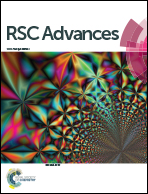Bio-complementary supramolecular polymers with effective self-healing functionality†
Abstract
Complementary nucleobase-functionalized polymers, a combination of base-pair interactions and a blend of two different polymers, can be used for efficient construction of supramolecular polymer networks; these materials exhibit tunable mechanical properties, rapid thermo-responsiveness and self-healing behavior making them highly attractive for a wide range of potential applications. Herein, a multi-uracil functionalized polyhedral oligomeric silsesquioxane (POSS-U) and adenine end-capped three-arm polycaprolactone oligomer (PCL-A) have been successfully developed and show high complementary ability in both solution and the solid state owing to reversible uracil–adenine (U–A)-induced physical cross-linking. The POSS-U/PCL-A blend system demonstrates that physically crosslinked films can be readily tailored to provide the desired mechanical properties and rapidly reprocessed after damage under mild temperature conditions. Importantly, these films can also spontaneously self-heal at room temperature as an autonomously repairing material, without the need for external intervention. Thus, this new system provides a potential route toward the design and fabrication of next-generation self-healing polymers.


 Please wait while we load your content...
Please wait while we load your content...